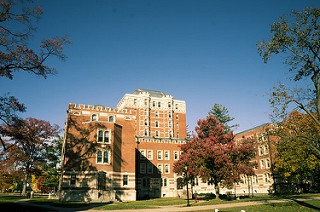Whenever students are asked about their college preferences, one of the things students consider is the size of the school. The majority of college match tools, including College Raptor, ask about preferred college size. There are small, medium, and large size colleges, but how do students know what the right size is for them? Each size has its own advantages that students should consider when building their college list.
College Size by Numbers
Small Size Colleges
“Small” colleges usually have fewer than 5,000 students. Many small colleges are private, including CalTech, Reed College (OR), and Vassar College (NY). While many public institutions are medium to large size, there are some that are considered small, including Oregon Institute of Technology, The Evergreen State College (WA), and SUNY Geneseo.
Medium Size Colleges
“Medium” colleges have student populations between 5,000 and 15,000 students.
There is a good mix of public and private colleges that fall in the medium-size category. Some examples of medium colleges include Yale, Stanford, and the University of Montana.
Large Size College
“Large” colleges have over 15,000 students. Many of the large colleges are public institutions, but there are some large private colleges as well. Examples of large colleges include most of the University of California campuses, USC, Harvard, and Ohio State.
Differences in College Size
Some of the selling points for small colleges include small class sizes, personal relationships with professors, and close-knit communities. Large colleges, on the other hand, usually offer hundreds of student organizations and active student communities.
However, did you know you can find most of these things at any size college?
Class Size
Small classes are not only found at small colleges. While many medium and large colleges have large lecture classes for introductory courses, they also offer small classes.
Some colleges will offer, and sometimes require, a “discussion” class in conjunction with a large lecture course where students will get together with classmates to discuss the lectures and course material. In addition, as students move to upper-level courses, the classes tend to get smaller.
Small classes are great for students who enjoy participating in class. Small classes also make it hard for students to stay anonymous because these small classes sometimes require students to speak up and participate. Larger classes, sometimes referred to as lecture classes, usually allow students to sit back and listen. Each class and professor has different ways of determining grades, but it is usually safe to assume smaller classes tend to use participation and attendance, while lecture classes will not.
Professor Relationships
Many admissions officers from small colleges share similar stories about their professors. Some of these stories include professors noticing when students miss class, professors having lunch with their students in the dining hall, and even professors inviting their students to their homes.
It’s easier for professors at the small colleges to do these things because their population is smaller. However, this is possible at bigger colleges as well. Students might have to seek out the professors at first by attending office hours or speaking up in class. But, if a relationship with your professor is important, it can happen at almost any campus if you put a little work into it.
Campus Communities
Smaller colleges make it easier for camaraderie with much of the student population. With a smaller student population, it is easier for students to get to know many of the other students on campus.
Although larger colleges make it almost impossible to know everyone on campus, it is possible to find a small community within a large college. Academic programs, student organizations, or residential communities can serve as a close-knit community for students at a bigger college.
Student Activities
Bigger colleges are usually able to offer hundreds of student organizations covering almost every interest you can imagine. These organizations are usually very specific to the interest. For example, instead of having one organization for Business majors, there might be a separate organization for students interested in Business Administration, Marketing, or Accounting, as well as a Business fraternity.
With so many options, students might find it hard to choose the right organizations or they may get over-involved in activities. Smaller colleges, on the other hand, usually have less student organization options. However, the organizations at smaller colleges are usually more general, making it easier to chose which organizations to join.
In addition, students at smaller colleges may not find an organization they want but can step up and create an organization.
Choosing the Right Size College: Small, Medium, or Large?
Every college has something great to offer, no matter the size of the student population. Since the different college sizes can offer the same opportunities, just in a different way, how should you choose the types of colleges to consider?
A lot of it will come down to your personality and how you will feel most comfortable.
However, if you are still unsure, a campus visit to the different college types might be in order. Even if you are just at the beginning stages of building your college list, a visit to local colleges of different sizes can help you to see and feel what size college feels best to you.
If college size does not matter at all to you, consider all college sizes when searching for colleges with your preferences.








Having worked on small campuses throughout my career, I’ve always felt like three options–small, medium, large–are too few to be helpful. There are significant differences between a school with 1000 students and one with 4000, and I am sure the same is true within the other categories. I wonder if, at the least, we ought to talk about tiny, small, medium, medium large, large and huge.